Spot News Roundup
RECOVERING DONOR ORGANS TO SAVE LIVES
A multidisciplinary team led by Gordana Vunjak-Novakovic, University Professor and Mikati Foundation Professor of Biomedical Engineering and Medical Sciences at Columbia Engineering, and Matt Bacchetta, associate professor of surgery at Columbia University Medical Center and New York-Presbyterian, has for the first time maintained a fully functional lung outside the body for more than two days.
Gordana Vunjak-Novakovic on Tissue Engineering
In a study published in Nature Biomedical Engineering, the researchers described their cross-circulation platform that maintained the viability and function of a donor lung and the stability of the recipient over the course of 36 to 56 hours. They used the advanced support system, based on a surgical procedure used in the 1960s, to recover lungs injured by restricted blood supply and make them suitable for transplant.
The number of end-stage lung disease patients far exceeds the quantity of donor lungs, which quickly lose their function outside the body and during transport. For the past five years, Vunjak-Novakovic and collaborators have investigated how to improve low-quality donor lungs and potentially bioengineer lungs for transplantation. Rather than attempt to build new organs, they developed strategies to rescue damaged donor lungs, and realized that a cross-circulation approach could enable long-term support of living organs outside the body by providing critical systemic and metabolic factors.
The study’s lead authors, PhD candidate John O’Neill and postdoctoral research fellow Brandon Guenthart, worked in Vunjak-Novakovic’s Laboratory for Stem Cells and Tissue Engineering to design a platform that mimics the chest cavity and allows for controlled delivery of drugs and cells. They believe the technology can extend to recover other organs in high demand, including livers and kidneys, and have already begun pursuing those possibilities.
“Our team worked hard to innovate a suite of imaging and targeted delivery technologies and ultimately completed this challenging, paradigm-shifting study in less than a year,” Vunjak-Novakovic said. “This was only possible because of our uniquely talented team of bioengineers and surgeons, and the highly collaborative environment at Columbia that fosters innovation.”
ADVANCING LANGUAGE TECHNOLOGY
Kathleen McKeown, Henry and Gertrude Rothschild Professor of Computer Science, Julia Hirschberg, Percy K. and Vida L. W. Hudson Professor of Computer Science, and Smaranda Muresan, a research scientist in the Data Science Institute and adjunct associate professor in computer science, have been awarded a $14.35 million, four-year Intelligence Advanced Research Projects Activity (IARPA) grant to develop an end-to-end cross-language retrieval system. McKeown is leading the project, which includes 13 faculty and research scientists at five different universities. Using natural language processing, this system will be capable of searching speech and text documents in multiple languages in response to a question posed in English, and then of automatically generating English summaries of relevant foreign-language documents. All at the rate of about 750 million words per day.
Their project, called the System for Cross-Language Information Processing, Translation, and Summarization, or SCRIPTS, will focus mainly on low-resource languages, such as Aramaic and Xhosa—the type of languages for which Google doesn’t have good machine translation.
McKeown brings expertise on summarization of text while Hirschberg brings that same expertise on speech. Muresan, on the other hand, focuses on the meaning of words in cross-lingual environments. By bringing together authorities on summarization, language morphology, and semantics—which can address ambiguities in search terms and in the documents themselves—the Columbia team overall can generate different ways of thinking to approach the problem.
“This is an exciting project that brings together many technologies in the field of human language technology,” McKeown said. “It will bring a significant advance in the state of the art in querying over foreign-language documents.”
At the same time, McKeown is also the recipient of a Defense Advanced Research Projects Agency (DARPA) grant, along with Shih-Fu Chang, Richard Dicker Professor of Electrical Engineering and professor of computer science. Chang and McKeown are part of a multiuniversity team being awarded a $15 million, four-and-a-half-year grant from DARPA’s Active Interpretation of Disparate Alternatives program. This team, led by the Information Sciences Institute at the University of Southern California, will develop intelligent systems that extract knowledge from diverse sources of multimedia information in different modalities. Columbia will receive a $2.33 million share of the funding.
BRIDGING BRAINS AND COMPUTERS
A team led by Professor Ken Shepard, a pioneer in developing electronics that interface with biological systems, recently received a four-year, $15.8 million grant from the U.S. Department of Defense’s Defense Advanced Research Projects Agency (DARPA) to invent an implanted brain-interface device that promises to transform the lives of people with neurodegenerative diseases or who are hearing and/or visually impaired.
While crude implanted electrode devices are currently available for mitigating the effects of Parkinson’s disease, epilepsy, and other neurodegenerative conditions, few patients use them because of their large size and extreme invasiveness. Smaller, less invasive devices with more channels capable of interacting with the brain would result in revolutionary improvements to brain-machine interfaces, including direct links to the auditory cortex and the visual cortex, helping artificial systems better support brain function.
“If we are successful, the tiny size and massive scale of this device could provide the opportunity for transformational interfaces to the brain, including direct interfaces to the visual cortex that would allow patients who have lost their sight to discriminate complex patterns at unprecedented resolutions,” said Shepard, the Lau Family Professor of Electrical Engineering and professor of biomedical engineering.
The project is under DARPA’s Neural Engineering System Design program, part of the larger federal government–wide BRAIN Initiative, aimed at developing an implantable neural interface that can provide unprecedented bandwidth between the brain and the digital universe. Shepard’s team includes Associate Professor of Computer Science Luca Carloni; faculty from Columbia’s Graduate School of Arts and Sciences; and researchers from Cal Tech, Duke, Northwestern, and other institutions.
Utilizing electrode architectures based on stimulation and recording at the brain surface, the researchers aim to create a device fitting more than a million electrodes on a single complementary metal oxide semiconductor (CMOS) integrated circuit. The implanted chips will be light, wireless, and flexible enough to move with brain tissue. They plan to apply for regulatory approval to begin experiments in patients at the end of the four-year program.
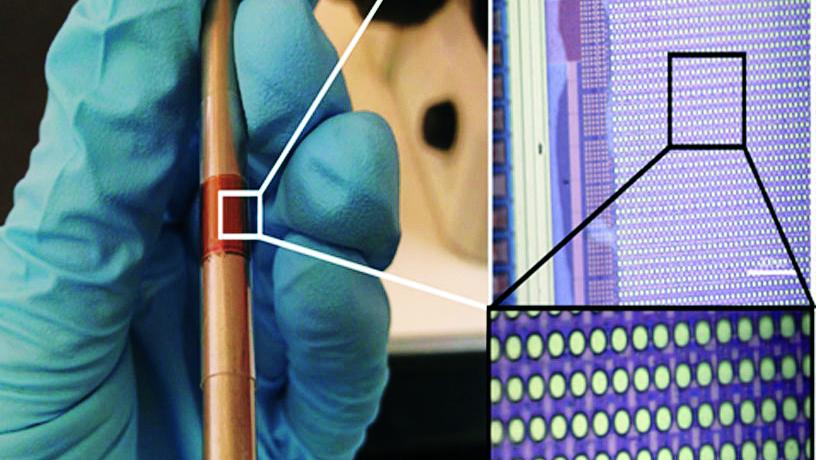
Photo courtesy of Ken Shepard
CANCER-FIGHTING BACTERIA
Statistically, one out of eight women in the United States develops invasive breast cancer at some point, with daunting prospects if the cancer metastasizes outside of local breast tissue. Researchers have spent years searching for alternative methods to chemotherapy, to which tumors often become resistant, with frustrating results. Enter Tal Danino, assistant professor of biomedical engineering, who recently won (among other awards) a four-year, $2.5 million grant from the U.S. Department of Defense for his work programming novel probiotic bacteria for cancer treatment.
Applying advances in synthetic biology, Danino’s Synthetic Biological Systems Laboratory is engineering bacteria by computationally modeling, and then constructing, genetic circuits that create complex, dynamic behaviors inside of living cells. His group can program bacteria to sense tumor environments and to produce a wide range of genetically encoded diagnostic and therapeutic agents.
“Our work is focused on transforming bacteria into ‘smart’ therapeutic delivery vehicles to treat breast cancer,” said Danino, a member of Columbia’s Data Science Institute and Herbert Irving Comprehensive Cancer Center. “We think that by engineering microbes that are more effective and less toxic, we can greatly reduce the mortality associated with metastatic breast cancer.”
Over the past decade, cancer researchers have discovered a wealth of beneficial microbes in the body, including those in breast tissue and human milk, and detected a surprising wealth of microbes within breast and other tumors previously believed sterile. Breast cancer has been associated with imbalances in these diverse communities of breast tissue microbes.
Danino aims to engineer orally deliverable, safe probiotics to selectively target metastatic tumor sites and effectively produce and release therapeutics within the local tumor environment. He envisions further research incorporating insights into how the microbiome shapes the development of breast malignancies and how the microbiome could be adjusted. “Using orally administered probiotics instead of surgery or chemotherapy could transform treatment regimens,” Danino said.
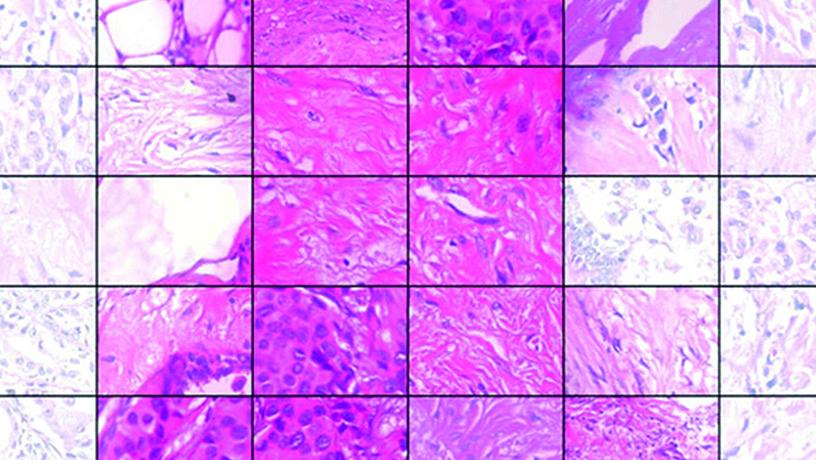
Photo courtesy of Tal Danino
THERAPEUTIC ROBOTS
Symptoms of cerebral palsy include crouch gait—characterized by excessive flexion of the hips, knees, and/or ankles, which contributes to joint degeneration over time. A team led by Sunil K. Agrawal, professor of mechanical engineering and of rehabilitation and regenerative medicine, recently published a pilot study in Science Robotics describing a robotic training method that improves posture and walking in children with crouch gait by enhancing their muscle strength and coordination.
Crouch gait is caused by a combination of extensor muscles too weak to keep posture upright with tight flexor muscles that limit joints’ range of motion. Among the extensor muscles, the soleus—a muscle that runs from just below the knee to the heel—is critical for standing and walking by facilitating extension of the knee and providing propulsive forces on the body. Because the soleus is activated more strongly when more weight is added during gait, the researchers reasoned that strengthening the soleus might help children with crouch gait to stand and walk.
To test their hypothesis, the team used a robotic system invented in Agrawal’s Robotics and Rehabilitation (ROAR) Laboratory, the Tethered Pelvic Assist Device (TPAD), with six children in training sessions over six weeks. The TPAD is a wearable, lightweight cable-driven robot that can be programmed to provide forces on the pelvis in desired directions as subjects walk on a treadmill. The team programmed the TPAD to apply additional downward force to intensively retrain the activity of the soleus muscles.
“We took an approach opposite to conventional therapy with these children,” said Agrawal, who is also a member of the Data Science Institute. “Instead of partial body weight suspension during treadmill walking, we trained participants to walk with a force augmentation.”
Examining a wealth of data from throughout training, the researchers found that the TPAD enhanced upright posture and muscle coordination in addition to improving the children’s gaits in general. They are now planning expanded clinical trials in hope of bringing their technique to more patients.
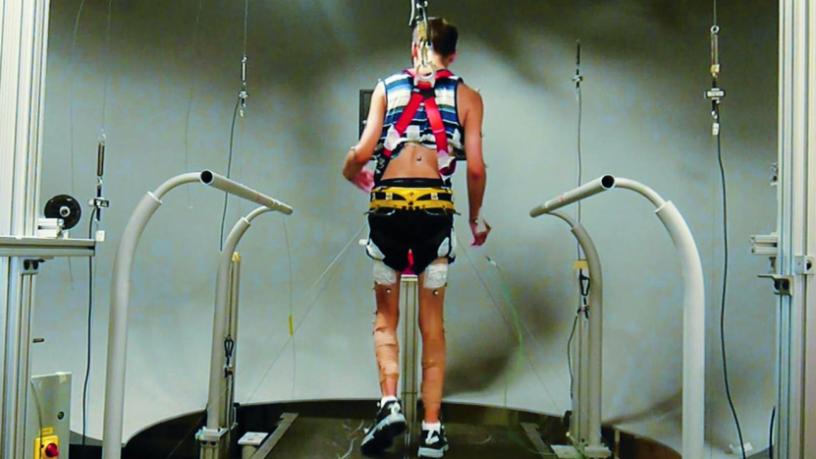
Photo courtesy of Sunil Agrawal
HEAR, HEAR
For people who are hearing impaired, hearing aids on the market have a major shortcoming: While devices can suppress background noise, they cannot help a user listen to a single conversation among many, such as at a noisy restaurant, as they are unable to determine which speaker the user is trying to listen to. A cognitive hearing aid that could monitor users’ brain activity to figure out if they are conversing with a specific speaker would be a dream come true.
Using deep neural network models, a research team led by Nima Mesgarani, associate professor of electrical engineering, has made a major advance in auditory attention decoding (AAD) methods that could make cognitively controlled hearing aids a reality. A study published in the Journal of Neural Engineering describes how Mesgarani’s team—in collaboration with Columbia University Medical Center’s Department of Neurosurgery, the Hofstra Northwell School of Medicine, and the Feinstein Institute for Medical Research—developed an end-to-end system that rapidly analyzes audio containing multiple speakers in the context of a listener’s neural signals, differentiates between the individual speakers, figures out who is being listened to, and amplifies the attended speaker’s voice.
“Our novel framework for AAD bridges the gap between the most recent advancements in speech processing technologies and speech prosthesis research and moves us closer to the development of realistic hearing aid devices that can automatically and dynamically track a user’s direction of attention and amplify an attended speaker,” said Mesgarani, a member of the Data Science Institute and the Mortimer B. Zuckerman Mind Brain Behavior Institute.
His team came up with the idea of a cognitively controlled hearing aid after they demonstrated it was possible to decode the attended target of a listener using neural recordings in humans and analyzing the neural responses in the listener’s brain.
“Our system demonstrates a significant improvement in both subjective and objective speech quality measures—almost all of our subjects said they wanted to continue to use it,” Mesgarani said.
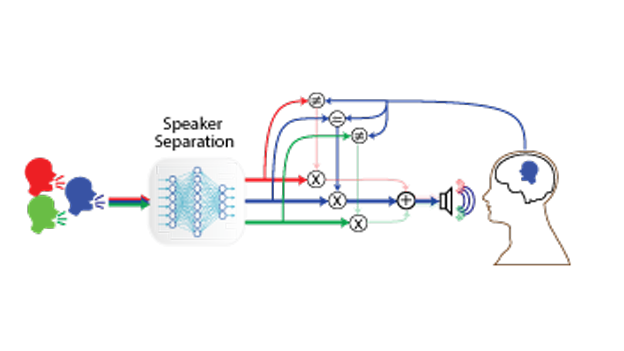
Diagram courtesy of Nima Mesgarani
THE FUTURE OF FORECASTING
A recent study led by Pierre Gentine, associate professor of earth and environmental engineering, analyzes global satellite observations to show that vegetation alters climate and weather patterns by as much as 30 percent. The paper, published May 29 in Nature Geoscience, is the first to look at biosphere-atmosphere interactions using purely observational data and could help improve weather and climate predictions critical to crop management, food security, and water supplies.
Vegetation affects climate and weather patterns through the release of water vapor during photosynthesis. The release of vapor alters surface energy fluxes and can form clouds, which affect the amount of sunlight reaching the Earth and in some areas can lead to precipitation. Recent advancements in satellite observations enabled the researchers to infer vegetation activity, using remote sensing data for precipitation, radiation, and temperature and statistically analyzing the cause and feedback loop between the terrestrial biosphere and the atmosphere. They are the first investigators of land-atmosphere interactions to determine both the strength of the predictive mechanism between variables and the timescale over which such links occur.
The study revealed that substantial vegetation-precipitation feedback loops often occur in semiarid or monsoonal regions—essentially hotspots that are major sources and sinks of CO2—and in several moderately wet regions, like the eastern United States and the Mediterranean, where precipitation and radiation increase vegetation growth. Such growth enhances heat transfer and increases the height of the Earth’s boundary layer, the lowest part of the atmosphere, affecting cloudiness and surface radiation.
“By more accurately observing and modeling the feedback between photosynthesis and the atmosphere, as we did in our paper, we should be able to improve climate forecasts on longer timescales,” Gentine said.
The researchers are now exploring ways to model how biosphere-atmosphere interactions may change with a shifting climate, as well as learning more about the drivers of photosynthesis, to better understand atmospheric variability.

Photo courtesy of Pierre Gentine
CREATING SUPERSTRONG POLYMERS
A research team led by Sanat Kumar, Bykhovsky Professor of Chemical Engineering, has demonstrated for the first time a technique for making superstrong and flexible polymers that takes inspiration from oyster shells’ nacre, a composite material with tremendous strength and resilience. By changing the crystallization speed of a polymer initially well mixed with nanoparticles, the team was able to control how the nanoparticles self-assemble into structures at three very different length-scale regimes. This multiscale ordering can make the base material almost an order of magnitude stiffer while still remaining lightweight and deformable.
“Essentially, we have created a one-step method to build a composite material that is significantly stronger than its host material,” said Kumar, an expert in polymer dynamics and self-assembly.
Researchers have long known that varying nanoparticle dispersion in polymer, metal, and ceramic matrices can dramatically improve material properties. In nacre, for instance, hierarchical nanoparticle ordering improves its mechanical properties while parallel aragonite layers form “bricks” that assemble into tough superstructures. Kumar’s group—experts in tuning the structure and therefore the properties of polymer nanocomposites—found that, by mixing nanoparticles in a solution of polymers and changing the crystallization speed, they could control how the nanoparticles self-assembled into the nano-, micro-, and macrometer scales.
“This controlled self-assembly is important because it improves the stiffness of the materials while keeping them tough,” Kumar said. “And the materials retain the low density of the pure semicrystalline polymer so that we can keep the weight of a structural component low—a property that is critical to applications such as cars and planes, where weight is a critical consideration.”
The researchers will next explore how particles move toward certain regions of the system, and develop methods to speed up the particle ordering. They then plan to explore other polymer/particle systems with potential use in buildings, bridges, and biodegradable materials.
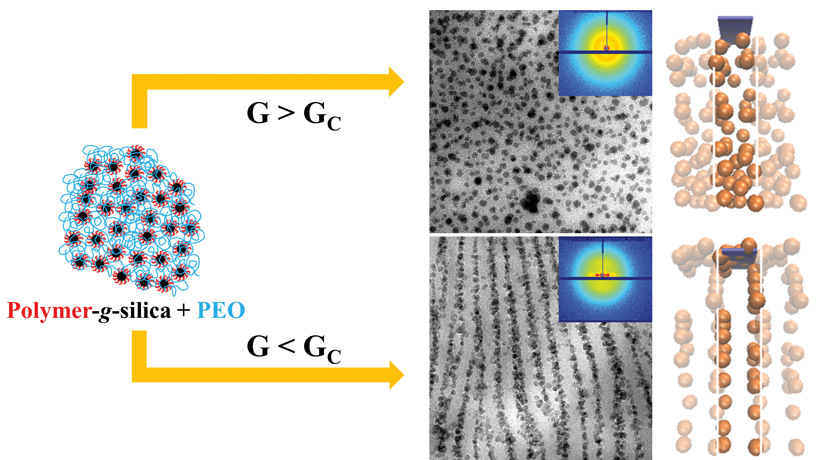
Diagram courtesy of Sanat Kumar
UNDERSTANDING CONCUSSIONS
Biomedical Engineering Professor Barclay Morrison has won a $2 million, five-year grant from the Paul G. Allen Family Foundation to study the underlying mechanisms of concussion. The award is part of a $9.25 million, multicenter research grant to explore the cellular mechanisms of concussion and the potential clinical interventions to improve recovery.
Morrison, whose Neurotrauma and Repair Laboratory studies the biomechanics of traumatic brain injury and brain cells’ death, notes that “concussion” describes a set of symptoms rather than an underlying cause. His group proposes that the mechanism of concussion symptoms is the disruption of the brain’s network layers due to both mechanical and physiological changes, leading to loss of normal electrical signaling across brain pathways. Still, most concussion patients experience a full recovery soon after injury.
Morrison and his team think that the damage and disruption can be reversed in these cases, allowing for the restoration of electrical signaling and processing. Even for patients with longer-term symptoms who may have permanent damage, the researchers hypothesize that the brain can gradually reroute signals around regions of damage. The team is developing a parallel approach of in vivo, in vitro, and computational models to ascertain how a combination of mechanisms leads to injury and repair. By accurately mimicking the biomechanics of concussion, the team will make corroborative comparisons among the models to learn how dysfunction and recovery progress from the molecular and cell level through the whole brain network. Their measurements at the single cell, circuit, vascular, and metabolic level will yield data for multilayered network models.
“We don’t know a lot about concussions,” says Morrison, co-PI on the project with Steven Kernie, an associate professor of pediatrics at Columbia University Medical Center. “Although concussion causes both acute and persisting neurocognitive dysfunction, the underlying cause has remained a mystery. This grant will enable us to examine both injury and recovery mechanisms in concussion to identify potential opportunities to help the brain repair itself.”

Photo by Eileen Barroso
WANG WINS NIH GRANT
Assistant Professor of Biomedical Engineering Qi Wang, who studies how the brain processes information about the outside world through the electrical activity of neurons, has won a National Institutes of Health (NIH) Research Project Grant. The five-year, $2 million award will support his project to study the role of the locus coeruleus (LC), a tiny nucleus buried deep in the brain stem, in regulating arousal in the brain that covaries with pupil size.
Arousal and attention strongly influence cognition, learning, and behavioral performance. Arousal—the level of physiological reactivity to environmental stimuli—is regulated by multiple neuromodulatory systems, including the LC, which is the principal site for brain synthesis of norepinephrine, a key neurotransmitter. Wang’s project will examine the LC’s role in modulating pupil-linked arousal, using pupillometry to measure pupil diameter while simultaneously recording behavior and LC activity.
“We are very happy to get such generous support from the NIH for our study,” says Wang, whose Laboratory for Neural Engineering and Control is focused on deciphering the neural code and exploring the possibilities of “writing” information into the brain through brain-machine interfaces in order to restore or enhance brain functions.
Abnormal activity in the LC has been implicated in a range of brain diseases/ disorders, including depression and schizophrenia. Wang’s group will address how the LC’s control of pupil size relates to its control of arousal and behavior, and whether they can infer LC activity from pupil size and other noninvasive measures of arousal, such as cortical EEGs. An inexpensive yet robust tool to estimate LC activity would help clinicians more accurately diagnose disorders and optimize therapy based on a quick and quantitative measurement of LC activity.
Wang hopes the study will lead to the development of new, powerful technologies that can infer LC activity using noninvasive, low-cost pupillometry methods, and he is planning collaborative studies of patients with neuropsychiatric disorders including ADHD, schizophrenia, autism, and depression.
“Our group is unusually crossdisciplinary—it pulls together researchers across the University, from engineering, physical and biological sciences, neuroscience, the medical school, and Lamont-Doherty Earth Observatory,” said Professor Steven Nowick, chair of the working group. “Interesting and unexpected breakthroughs come when computer systems and diverse applications researchers come together and collaborate.”
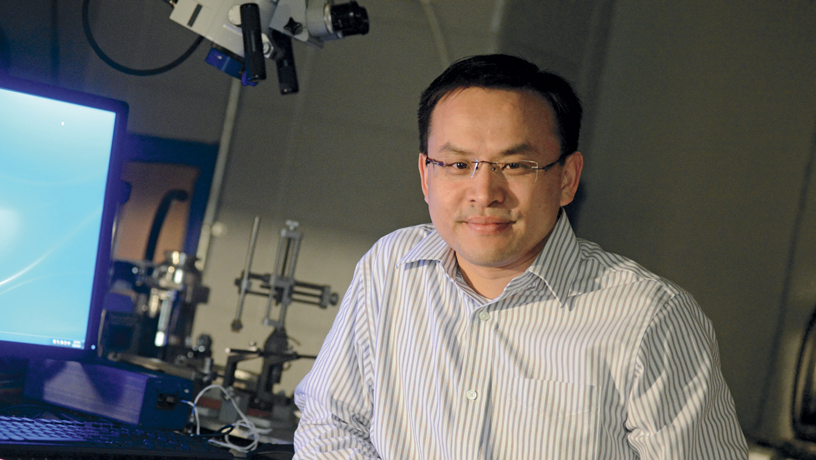
Photo by Jane Nisselson
